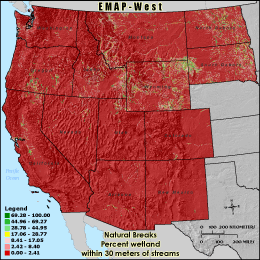|
|
Methodology and Interpretation
RWETL30 - Percent wetland within 30 meters of streams
The percentage of wetland cover within 30 meters of a stream is calculated by
summing the number of wetland land cover cells underneath stream segments in the
3 km grid cell reporting unit and within a one cell buffer (30 meters) and dividing
by the stream corridor's total land area (all cells 30 meters adjacent to streams
minus those classified as water). Cells inside the buffer zone but outside of the
grid cell boundary are ignored. Forests and wetlands act as filters, removing
pollutants from runoff before it enters streams. Forests and wetlands also
provide habitat for a wide variety of valuable plant and wildlife species.


Quantile: Each class contains an approximately equal number (count) of features. A quantile
classification is well-suited to linearly distributed data. Because features are grouped by the number
within each class, the resulting map can be misleading, in that similar features can be separated into
adjacent classes, or features with widely different values can be lumped into the same class. This
distortion can be minimized by increasing the number of classes.
Natural Breaks: Classes are based on natural groupings of data values. Natural break points
are identified by looking for groupings and patterns inherent in the data. The features are divided
into classes whose boundaries are set where there are relatively large jumps in the distribution of
data values.
* EMAP-West Landscape Metrics Metadata (FGDC)
|
|

